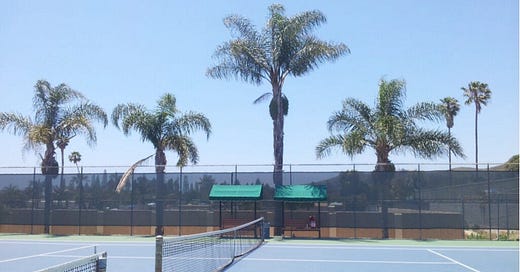Every game is composed of two parts, an outer game and an inner game. — Timothy Galway
I remember when I first read Timothy Gallwey’s book The Inner Game of Tennis. I was an average tennis player with a higher than average level of fear, doubt and insecurity on the court. I was a master at getting a big lead and then losing the set/match. I was tense and tight. I was not having fun.
Then I read Gallwey’s book and got a glimpse at the mental side of a game that I had always considered to be only about physical skill and technique. I learned to find/stay in the zone: to focus on the ball, quiet my worries, awaken my senses and let my skills (such as they were) come on line. In short, I played better and enjoyed playing more. I have been working on my inner game (on and off the court) ever since.
Being in the zone/flow is a pleasurable experience of focused immersion in an activity
The field of performance psychology has grown over the past decades. The concepts of mindfulness and flow have added to our understanding of optimal performance states and also of that elusive but cherished goal: happiness. Being in the zone/flow is a pleasurable experience of focused immersion in an activity. It is described in very similar terms by people when they are asked to describe their best ever performance. They use words like:
It felt effortless. I was completely focused on what I was doing but it wasn’t like I was doing it. I wasn’t trying or pushing myself. It was just happening and I was letting it happen. It’s like my self was getting out of the way. It was a very blissful experience that lasted for X minutes and then stopped. I wish I could recapture that. It was great!
It turns out that creating flow experiences is a process that can be learned and refined. It takes practice like any valuable skill, and it is not something that comes immediately or easily, but most things of value are like that. Here are some useful guidelines that can help us get/stay in the zone/flow:
ENABLERS OF FLOW
Use a well-developed skill/talent in an area of intrinsic interest
Engage in an activity with the just-right level of challenge (not too hard or too easy)
Quiet the mind (inner analyst/critic/worrier)
Focus on the here-and-now sensory experience of what you are doing
Maintain a hopeful/optimistic attitude (“I can do this!”)
Work within your sphere of control/autonomy
Remove (or screen out) external distractions
Maintain good general health/fitness
KILLERS OF FLOW
Strain to do something you’re neither good at nor interested in
Do something that is really easy or too difficult
Overthink/criticize your performance
Be afraid; be very afraid!
Regret the past and worry about the future
Have pessimistic/hopeless thoughts
Low control environments (can you say “micromanaged”?)
External sensory distractions (noise, etc.)
Inadequate sleep/nutrition/fitness
One of the most important lessons learned from the study of high performance is that the old adage “no pain/no gain” is somewhat misleading. While it is true that considerable effort and practice are required to achieve a solid level of skill which is a requirement for achieving flow, it turns out that suffering for its own sake builds neither character nor success (parents and teachers and managers and coaches take note!). People do their best when they are interested in and enjoying what they are doing and have a lot of control over their own performance (especially the “how”).
Morale matters.
Happiness and success intersect.




Excellent article that beautifully describes flow in a way that it can be automatically applied!